Bamboo as a Sustainable Building Material—Culm Characteristics and Properties
Abstract
:1. Introduction
- D. asper is one of the most popular bamboo species of Thailand. Its culms have thick walls. They are very strong and durable and are used as a building material for houses and bridges, furniture, musical instruments, chopsticks, household products, and handicrafts.
- D. sericeus is a moderately large bamboo with tightly clustered, straight, bluish-green culms with a large diameter. The thick-walled culms are advantageous for producing laminated bamboo lumber products such as glued laminated bamboo beams, floors, and cutting boards.
- D. membranaceus is a medium-sized clumping bamboo. Its culms are straight and usually between 20–24 m high and 6–10 cm in diameter. The internodes are covered with a white powdery deciduous scurf when young but become green upon maturity. This species is suitable for building purposes, furniture, bamboo boards, agricultural implements, household products, and as props for fruit trees. It is also one of the most promising species for paper pulp.
- T. oliveri is a tropical clumping bamboo with short rhizomes. Its culms are straight with a small diameter. The culms are valued as a local source of material for construction. Moreover, they are also used to reinforce concrete blocks, basketry, handicraft, and broom handles.
- P. makinoi is an evergreen bamboo. The rhizomes are elongated, with the plant having a running habit that can produce new shoots some distance from the main clump. Its culm is hard and dense and is stiffly erect. The culms are widely used in construction, furniture, pulpwood, handicraft, and splits for weaving.
2. Materials and Methods
2.1. Raw Material Sampling and Preparation
2.2. Investigation of Bamboo Culm Characteristics
2.3. Examination of Bamboo Culm Properties
- Moisture content: Samples of 25 mm × 25 mm × wall thickness were taken near the failure location to determine moisture content and density. The samples were cut from the different parts (node and internode). The initial weight before drying was weighed. Then, the samples were dried in an oven at a temperature of 103 ± 2 °C. After 24 h, the mass was recorded. For each test piece, the moisture content (MC) was calculated by using Equation (1).where m1 is the mass before drying (g) and m0 is the mass after oven drying (g).
- Density: The samples used in the determination of moisture content were the same used for density determination. The oven-dried density (D) of each sample was calculated using Equation (2).where m0 is the mass of the sample after oven drying (g) and V is the sample volume (mm3).
- Shear strength parallel to grain test: The samples were taken from the node and internode parts along the culm length. The sample length was equal to the outer culm diameter. The test was carried out by using a universal testing machine. The specimens were supported at the lower end over two quarters. The load was applied at the upper end over the two quarters with a constant speed of 0.01 mm/s. Figure 2a shows the setup of the shear strength parallel to grain test. The ultimate shear strength parallel to the grain (τult) was calculated using Equation (3). The density and moisture contents were determined for each specimen.where Fult is the maximum shear load at which the sample failed (N) and As is the total failed area (mm2).
- Tensile strength parallel to grain test: In order to compare the effects of the node and internode parts on tensile strength parallel to the grain, the test was conducted on specimens prepared in wedge shapes with the node and internode parts, as shown in Figure 2b. The specimen length was 260 mm with a 20 mm width of the specimen grip. The gauge length of specimens was 65 mm, the width was 10 mm, and the thickness was according to the culm wall thickness. Both ends of the specimens were tightly clamped between the metal grips of a universal testing machine, as presented in Figure 2b. The tensile load was applied to the specimens at a constant rate of 0.01 mm/s. The ultimate tensile strength parallel to the grain (σult) was calculated by using Equation (4). Failure of the specimens outside the gauge part was discarded. The density and moisture contents were determined from the gauge part for each specimen.where Fult is the maximum tensile load at which the specimen failed (N) and A is the area of the gauge part that failed (mm2).
- Compressive strength parallel to grain test: The specimens without nodes were prepared. The specimen length was equal to the outer culm diameter (D) or ten times the culm wall thickness (10T). The test was performed using a universal testing machine. The load was applied through a metal bearing plate, as shown in Figure 2c, which was placed across the upper surface of the culm wall thickness and at right angles to the specimen length. The load was applied at a constant speed of 0.01 mm/s. The maximum compressive strength parallel to the grain (σult) was calculated by using Equation (5). The density and moisture contents were determined for each specimen.where Fult is the maximum load at which the sample failed (N) and A is the cross-sectional area (mm2).
- Bending strength test: The four-point static bending test method was performed with some modifications to ISO 22157-1: 2004 [7], because of the limitation of span length. The samples with 1 m length were tested using a universal testing machine equipped with a computerized data acquisition system. The load was applied at midway between the centers of the device supports, as illustrated in Figure 2d, with a constant speed of the movable crosshead at 0.5 mm/min until specimen failure occurred. The Modulus of Rupture (MOR) and Modulus of Elasticity (MOE) were calculated by using Equations (6) and (7), respectively. The specimens were cut near the point of failure for specific gravity and moisture content determinations.where F is the maximum load (N), L is the free span (mm), D is the outer culm diameter (mm), IB is the second moment of area (mm4), and δ is the deflection mid-span (mm).
3. Results and Discussion
3.1. Characteristic of Bamboo Culm
3.2. The Physical and Mechanical Properties of Bamboo Culms
3.2.1. Moisture Content
3.2.2. Density
3.2.3. Shear Strength Parallel to Grain
3.2.4. Tensile Strength Parallel to Grain
3.2.5. Compressive Strength Parallel to Grain
3.2.6. Bending Strength
4. Conclusions
- Each bamboo species shows different culm characteristics along the culm length. The internode length increases from the bottom to the middle part and decreases towards the top part. Bamboo culm tapers towards the top with a decrease in the outer culm diameter. The culm wall thickness decreases from the bottom to the top part of the culm.
- The density of the five bamboo species varies from 594–933 kg/m3. Density significantly increases from the bottom to the top of the culm. Bamboo density affects the strength of bamboo culm. With the increase of density, the strength value also increases.
- For the five bamboo species, shear strength parallel to the grain varies from 13 to 50.2 MPa. Tensile strength parallel to the grain varies from 71 to 216 MPa. Compressive strength parallel to the grain varies from 56 to 132.9 Mpa. MOR varies from 29.3 to 102 MPa, and MOE varies from 1306 to 4134 MPa.
- Based on the mechanical properties, P. makinoi has the highest value in shear, tensile, compressive, and bending strength because of its highest density. However, D. asper can receive the highest ultimate load due to its culm size.
- Culm diameter and wall thickness affect the received ultimate load. A larger culm diameter with a thicker culm wall can receive more ultimate load.
- Nodes present along the bamboo culm show higher shear strength parallel to the grain when compared to internodes. However, nodes have a negative effect on tensile strength parallel to the grain. The tensile strength of nodes is lower than that of internodes.
- From an architectural and engineering point of view, bamboo is recognized as a sustainable building material. Its lightweight and superior physical and mechanical properties have attracted the attention of civil engineers, architects, academics, designers, and artists.
Author Contributions
Funding
Institutional Review Board Statement
Informed Consent Statement
Data Availability Statement
Acknowledgments
Conflicts of Interest
References
- Canavan, S.; Richardson, D.M.; Visser, V.; Le Roux, J.J.; Vorontsova, M.; Wilson, J.R. The global distribution of bamboos: Assessing correlates of introduction and invasion. AoB Plants 2017, 9, 1–18. [Google Scholar] [CrossRef] [PubMed] [Green Version]
- Jayanetti, L.; Follet, P. INBAR Technical Report 16: Bamboo in Construction—An Introduction; International Bamboo and Rattan Organization: Beijing, China, 1998.
- Tahmasebinia, F.; Ma, Y.; Joshua, K.; Sepasgozar, S.M.E.; Yu, Y.; Li, J.; Sepasgozar, S.; Marroquin, F.A. Sustainable architecture creating arches using a bamboo grid shell structure: Numerical analysis and design. Sustainability 2021, 13, 2598. [Google Scholar] [CrossRef]
- Shen, L.; Yang, J.; Zhang, R.; Shao, C.; Song, X. The benefits and barriers for promoting bamboo as a green building material in China—An integrative analysis. Sustainability 2019, 11, 2493. [Google Scholar] [CrossRef] [Green Version]
- Sungkaew, S.; Teerawattananon, A.; Chindawang, K. Bamboo in Thailand; Center of Excellence for Bamboos, Kasetsart University: Bangkok, Thailand, 2014. [Google Scholar]
- International Organization for Standardization. Bamboo—Determination of Physical and Mechanical Properties—Part II: Laboratory Manual; ISO 22157-2; ISO: Geneva, Switzerland, 2004. [Google Scholar]
- International Organization for Standardization. Bamboo—Determination of Physical and Mechanical Properties—Part I: Requirement; ISO 22157-1; ISO: Geneva, Switzerland, 2004. [Google Scholar]
- Simpson, W.T. Drying and control of moisture content and dimensional changes. In Wood Handbook: Wood as an Engineering Material; Forest Products Laboratory, United States Department of Agriculture: Madison, WI, USA, 1999; pp. 12.1–12.20. [Google Scholar]
- Rautkari, L.; Hill, C.A.S.; Curling, S.; Jalaludin, Z.; Ormondroyd, G. What is the role of the accessibility of wood hydroxyl groups in controlling moisture content? J. Mater. Sci. 2013, 48, 6352–6356. [Google Scholar] [CrossRef]
- Zhang, Y.; Huang, X.; Yu, Y.; Yu, W. Effects of internal structure and chemical compositions on the hygroscopic property of bamboo fiber reinforced composites. Appl. Surf. Sci. 2019, 492, 936–943. [Google Scholar] [CrossRef]
- Kumar, S.; Dobriyal, P.B. Treatability and flow path studies in bamboo. Part 1. Dendrocalamus strictus nees. Wood Fiber Sci. 1992, 24, 113–117. [Google Scholar]
- Huang, P.; Chang, W.S.; Ansel, M.P.; John Chew, Y.M.; Shea, A. Density distribution profile for internodes and nodes of Phyllostachys edulis (Moso bamboo) by computer tomography scanning. Constr. Build. Mater. 2015, 93, 197–204. [Google Scholar] [CrossRef]
- Huang, X.; Li, F.; De Hoop, C.F.; Jiang, Y.; Xie, J.; Qi, J. Analysis of Bambusa rigida bamboo culms between internodes and nodes: Anatomical characteristics and physical–mechanical properties. For. Prod. J. 2018, 68, 157–162. [Google Scholar] [CrossRef]
- Green, D.W.; Winandy, J.E.; Kretschmann, D.E. Mechanical properties of wood. In Wood Handbook: Wood as an Engineering Material; Forest Products Laboratory, United States Department of Agriculture: Madison, WI, USA, 1999; pp. 4.1–4.45. [Google Scholar]
- Abd Latif, M.; Liese, W. Culm characteristics of two bamboos in relation to age, height and site. In Bamboo for Sustainable Development, Proceedings of the 5th International Bamboo Congress and 6th International Bamboo Workshop, San José, Costa Rica, 2–6 November 1998; Kumar, A., Ramanuja Rao, I.V., Sastry, C., Eds.; VSP B.V.: Zeist, The Netherlands, 1998; pp. 223–233. [Google Scholar]
- Chaowana, P.; Barbu, M.C.; Frühwald, A. Bamboo-A functionally graded composite material. For. Prod. J. 2015, 65, S48–S53. [Google Scholar]
- Dixon, P.G.; Ahvenainen, P.; Aijazi, A.N.; Chen, S.H.; Lin, S.; Augusciak, P.K.; Borrega, M.; Svedström, K.; Gibson, L.J. Comparison of the structure and flexural properties of Moso, Guadua and Tre Gai bamboo. Constr Build. Mater. 2015, 90, 11–17. [Google Scholar] [CrossRef] [Green Version]
- Akinbade, Y.; Harries, K.A.; Flower, C.V.; Nettleship, I.; Papadopoulos, C.; Platt, S. Through-culm wall mechanical behaviour of bamboo. Constr Build. Mater. 2019, 216, 485–495. [Google Scholar] [CrossRef]
- Malanit, P.; Barbu, M.C.; Frühwald, A. Mechanical Properties of Sweet Bamboo Dendrocalamus asper. J. Bamboo Ratt. 2009, 8, 151–160. [Google Scholar]
- Shao, Z.P.; Zhou, L.; Liu, Y.M.; Wu, Z.M.; Arnaud, C. Differences in structure and strength between internode and node sections of Moso bamboo. J. Trop For. Sci. 2010, 22, 133–138. [Google Scholar]
- Oka, G.M.; Triwiyono, A.; Awaludin, A.; Siswosukarto, S. Effects of node, internode and height position on the mechanical properties of Gigantochloa atroviolacea bamboo. Procedia Eng. 2014, 95, 31–37. [Google Scholar] [CrossRef] [Green Version]
- Chaowana, P.; Barbu, M.C. Bamboo: Potential material for biocomposites. In Lignocellulosic Fibre and Biomass-Based Composite Materials-Processing, Properties and Application; Jawaid, M., Tahir, P.M., Saba, N., Eds.; Woodhead Publishing: Duxford, UK, 2017; pp. 259–289. [Google Scholar]
- Lee, A.W.C.; Bai, X.; Peralta, P.N. Selected physical and mechanical properties of giant timber grown in South Carolina. For. Prod. J. 1994, 44, 40–46. [Google Scholar]
- Srivaro, S.; Jakranod, W. Comparison of physical and mechanical properties of Dendrocalamus asper Backer specimens with and without nodes. Eur. J. Wood Wood Prod. 2016, 74, 893–899. [Google Scholar] [CrossRef]
- Ikponmwosa, E.; Fapohunda, C.; Kolajo, O.; Eyo, O. Structural behaviour of bamboo-reinforced foamed concrete slab containing polyvinyl wastes (PW) as partial replacement of fine aggregate. J. King Saud Univ. Sci. 2015, 16, 1–8. [Google Scholar] [CrossRef] [Green Version]
- Javadian, A.; Wielopolski, M.; Smith, I.F.C.; Hebel, D.E. Bond-behavior study of newly developed bamboo-composite reinforcement in concrete. Constr. Build. Mater. 2016, 122, 110–117. [Google Scholar] [CrossRef]
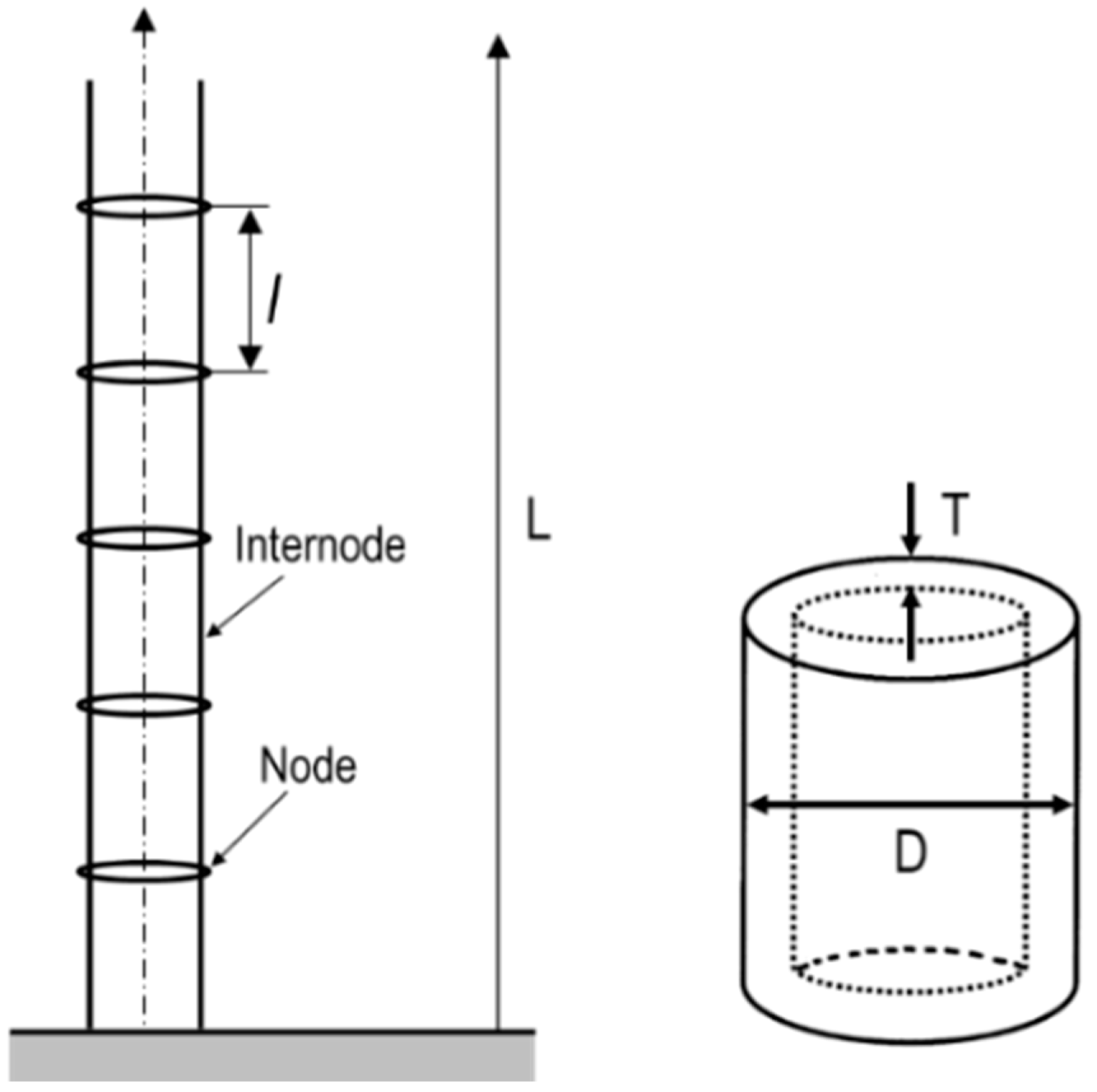
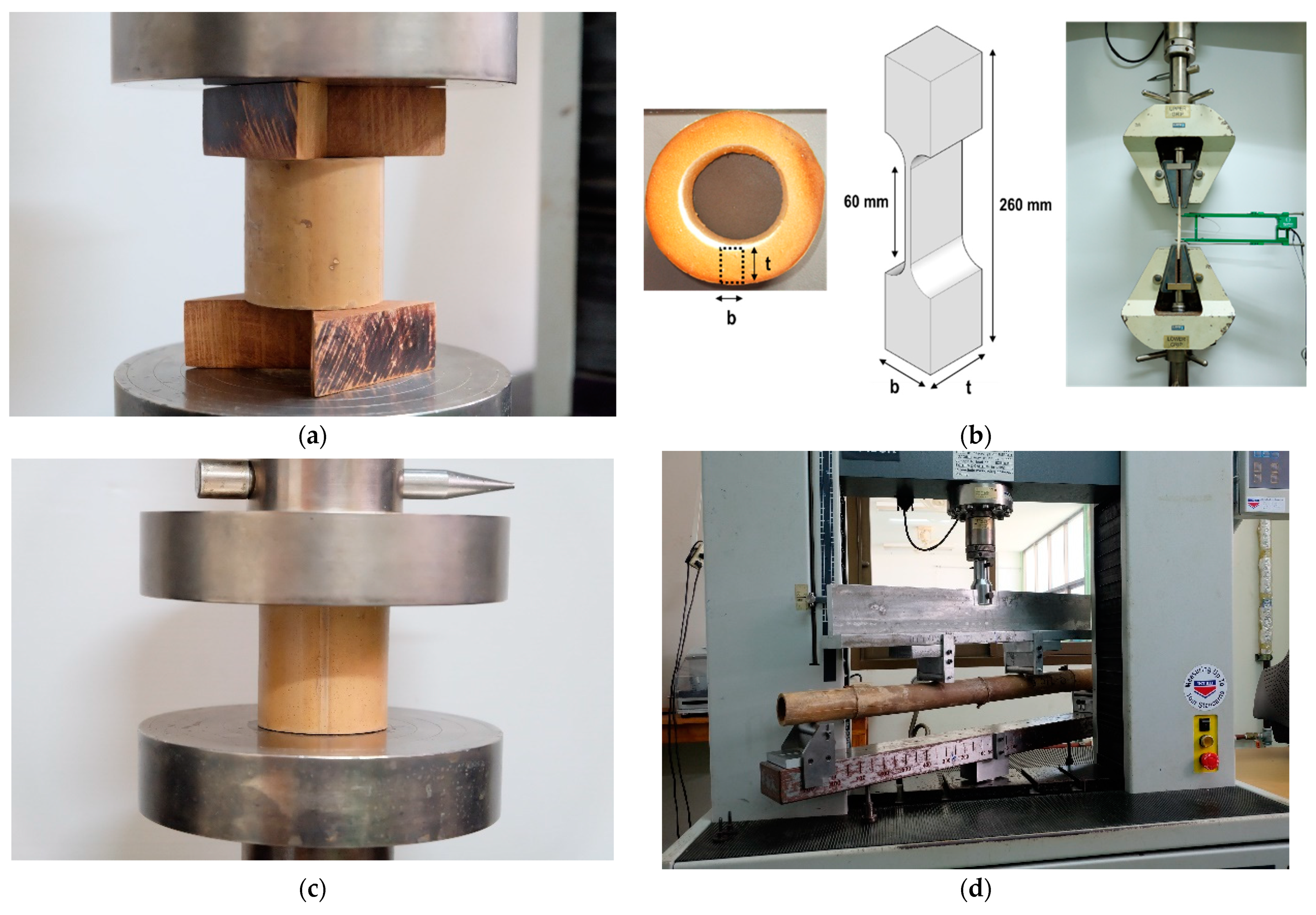

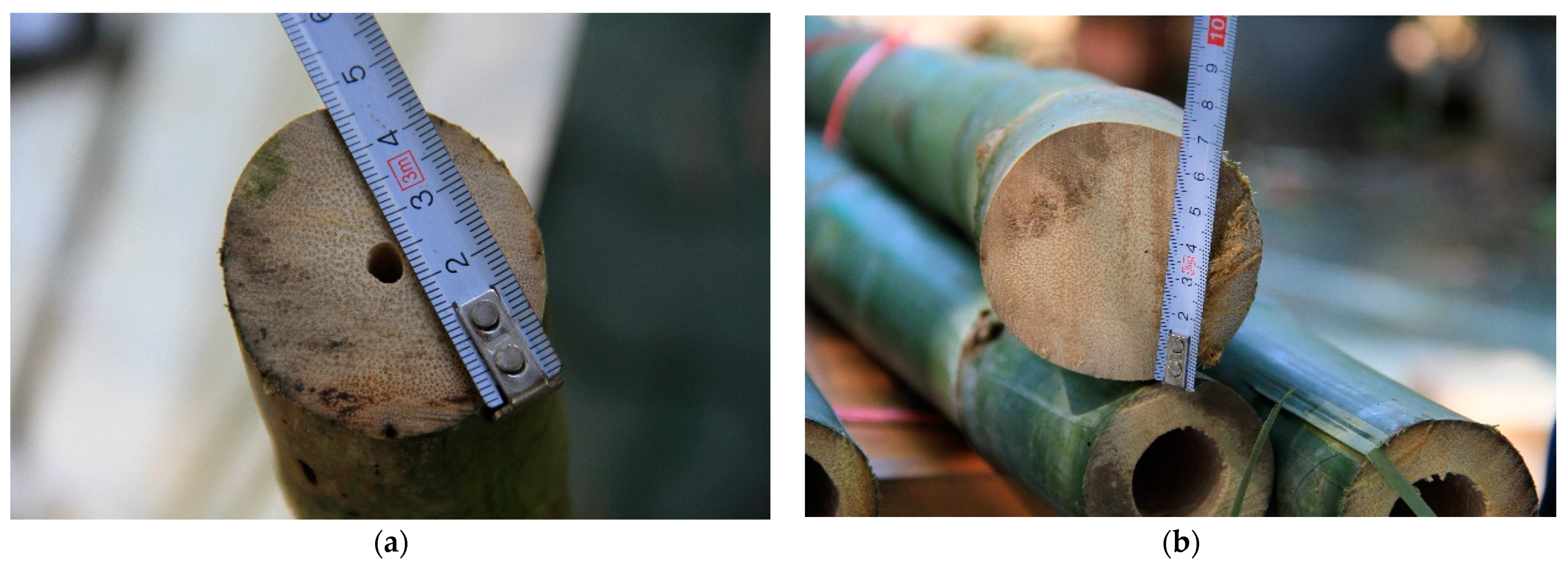
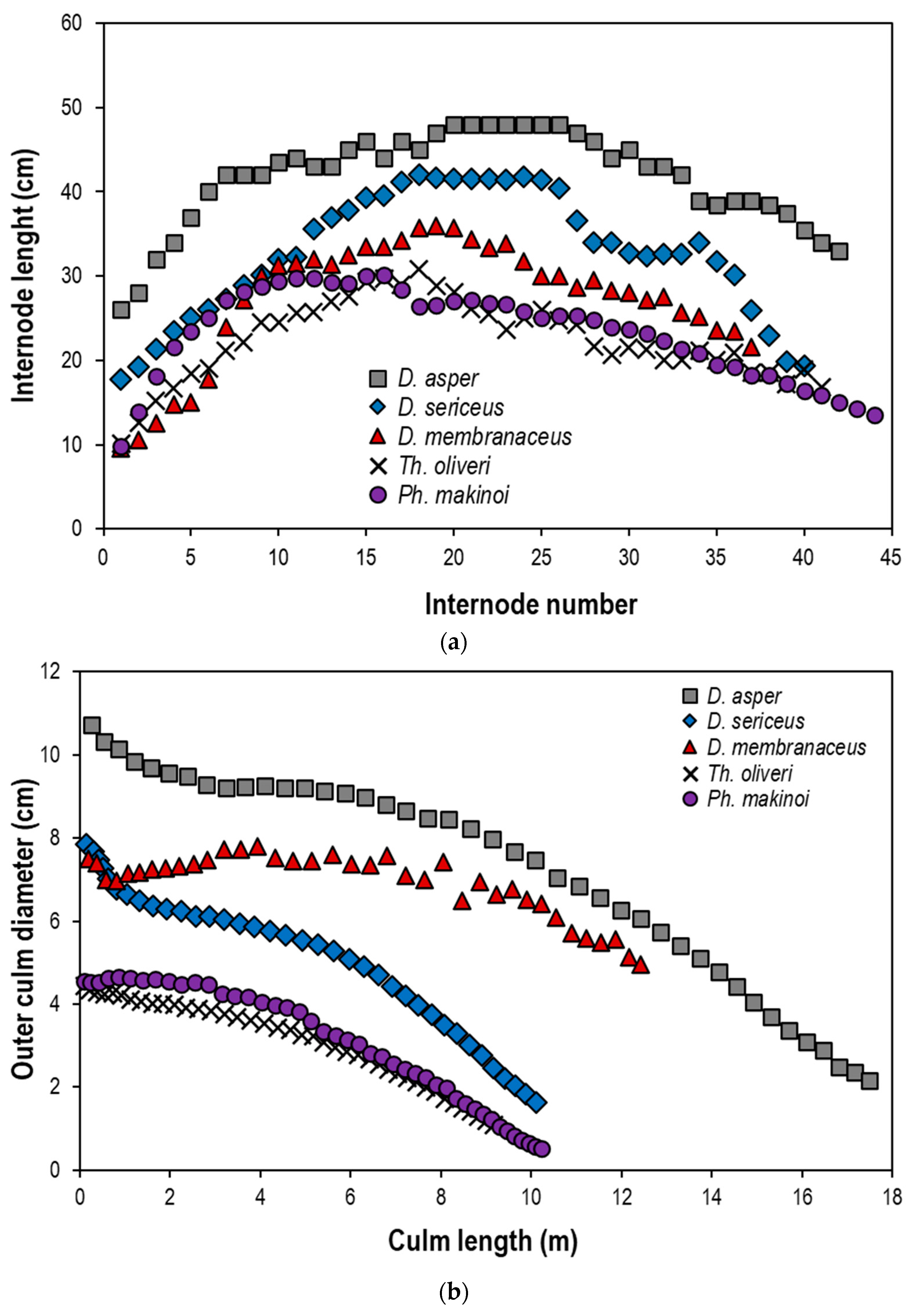
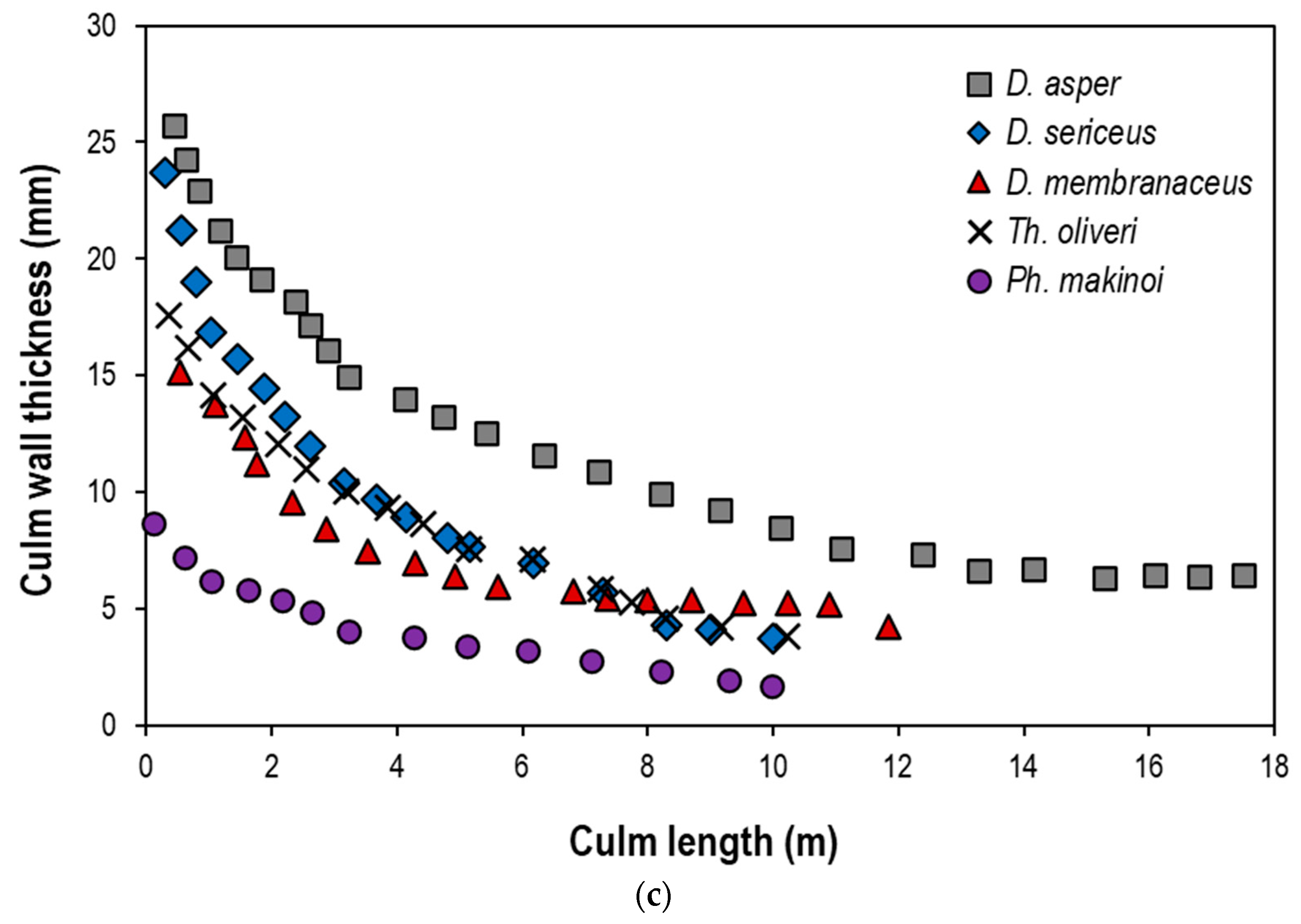
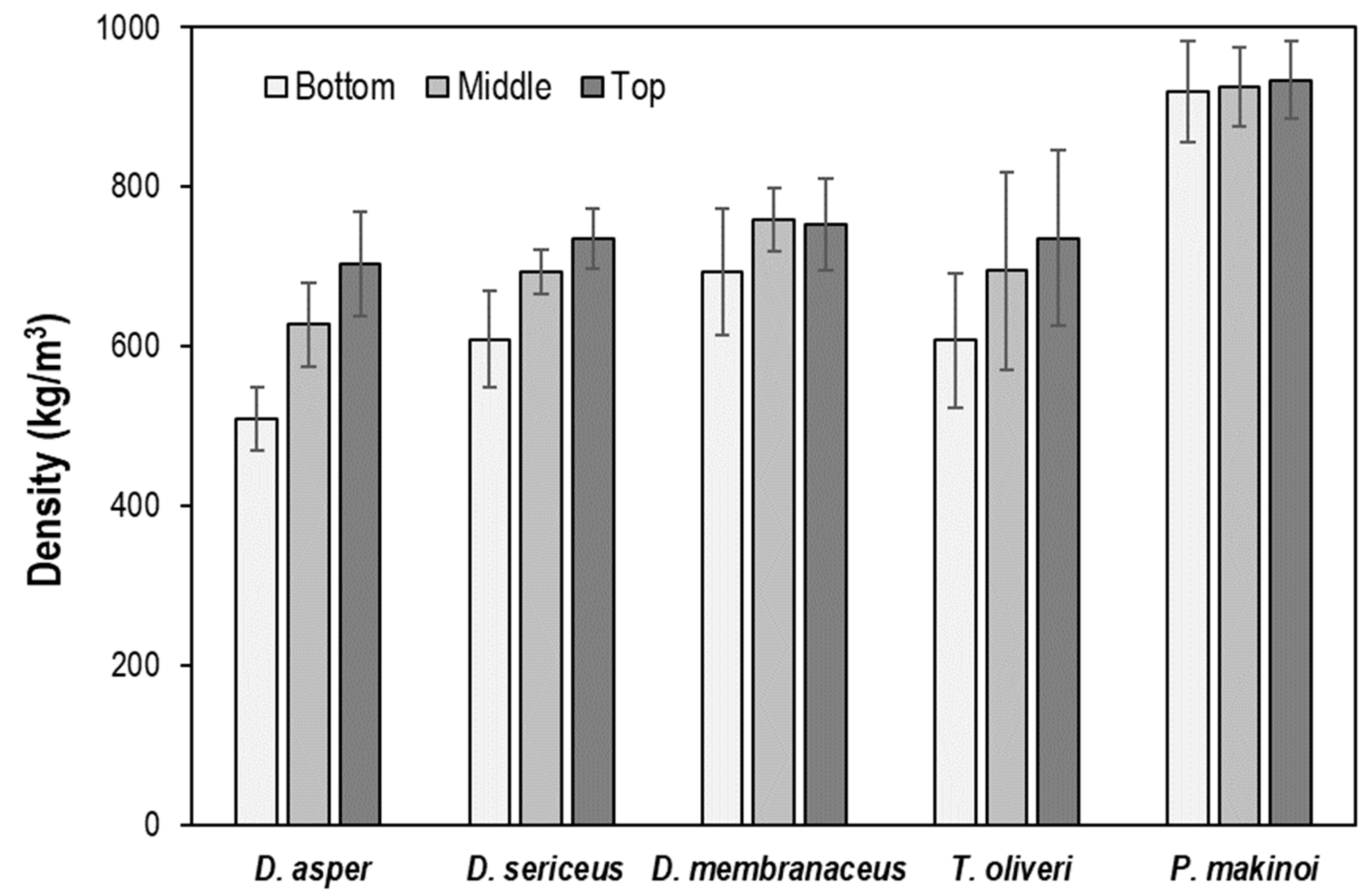

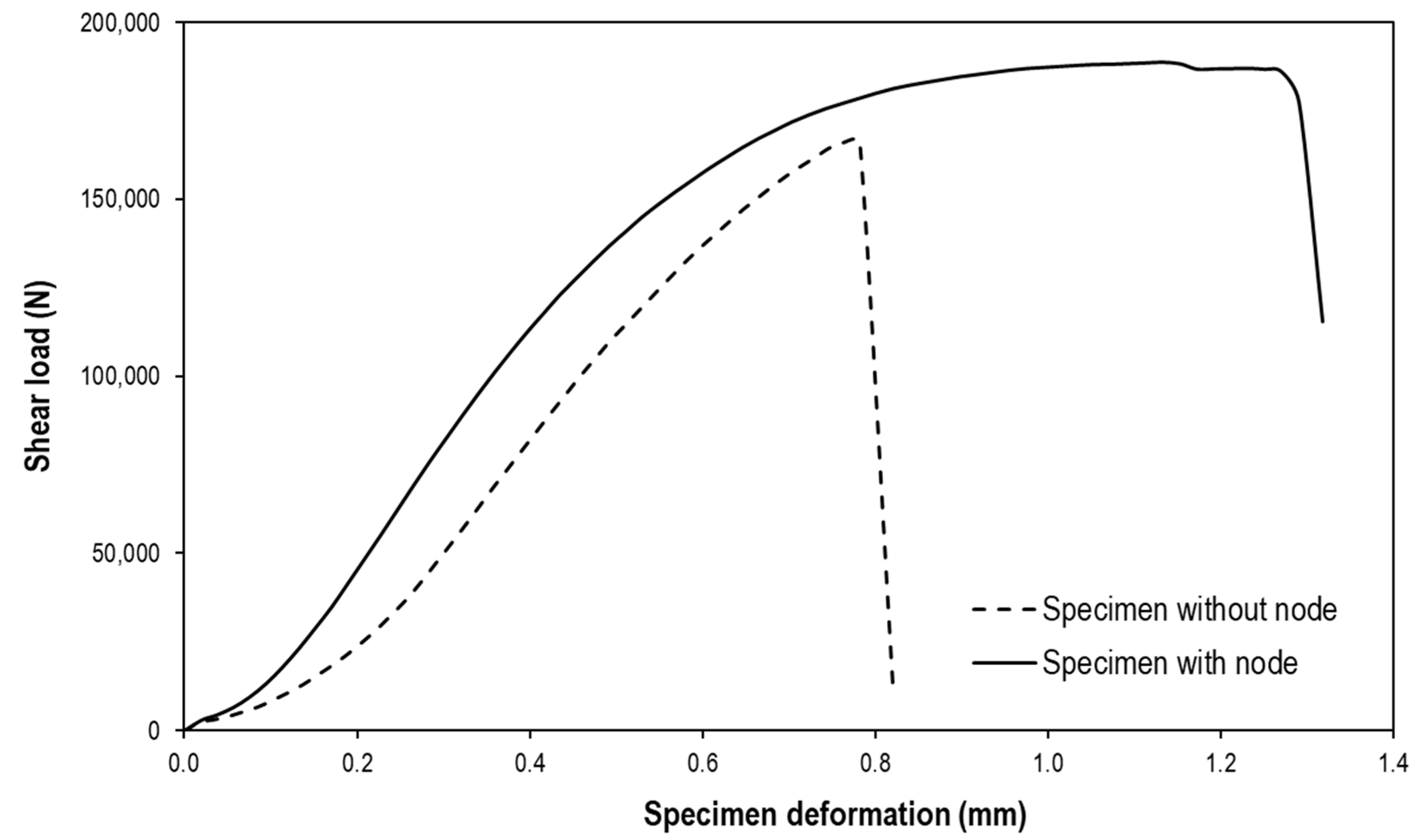
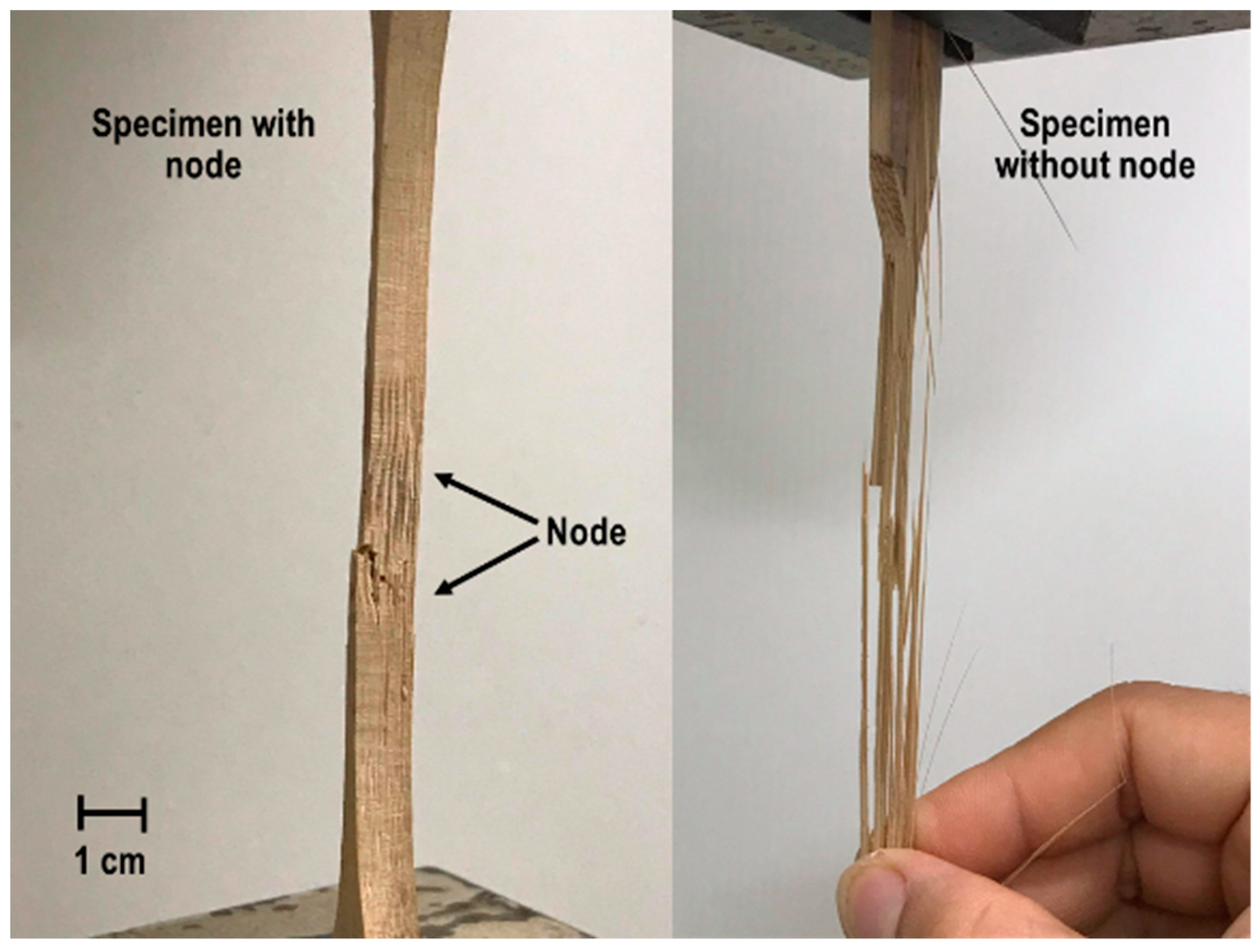
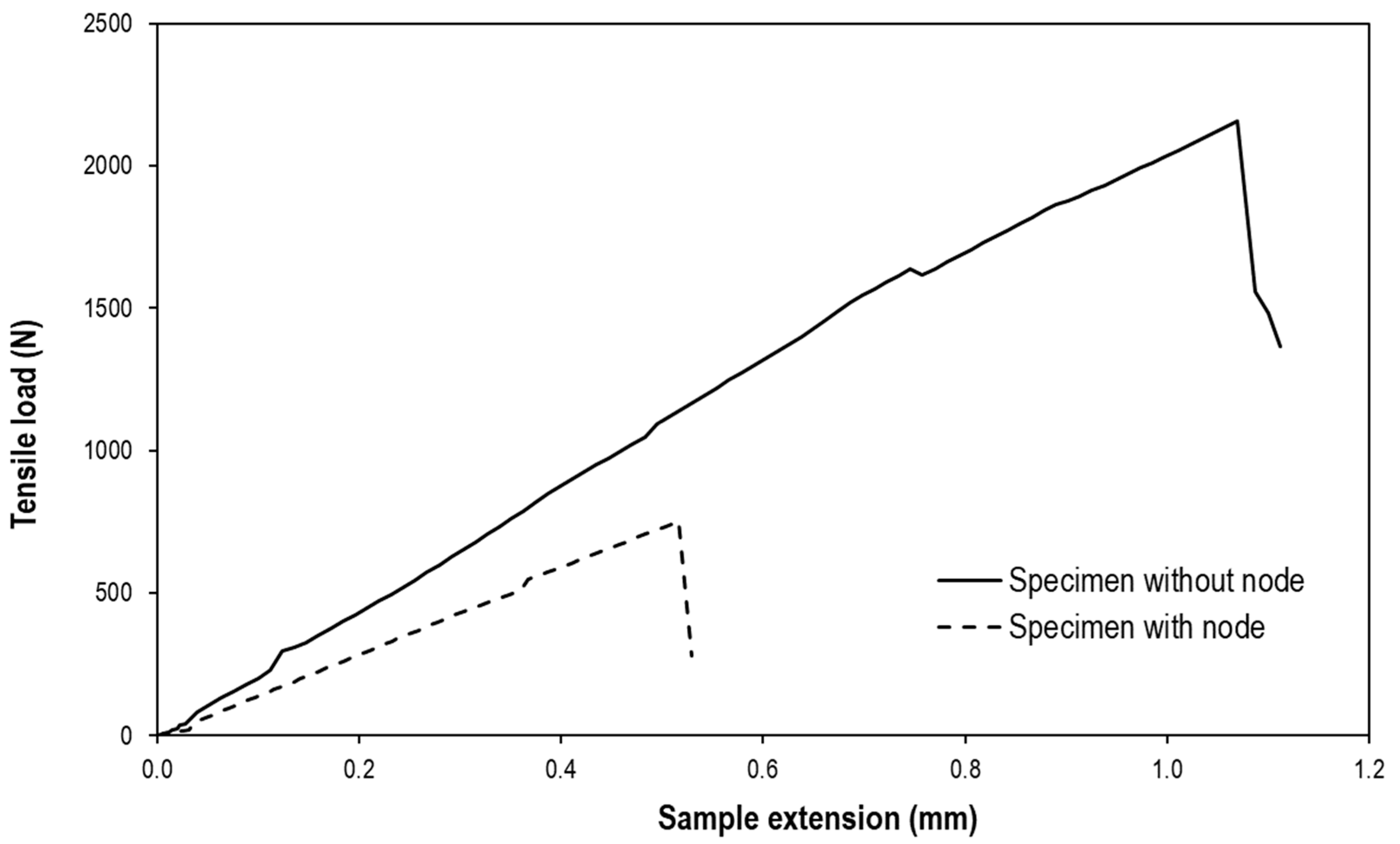
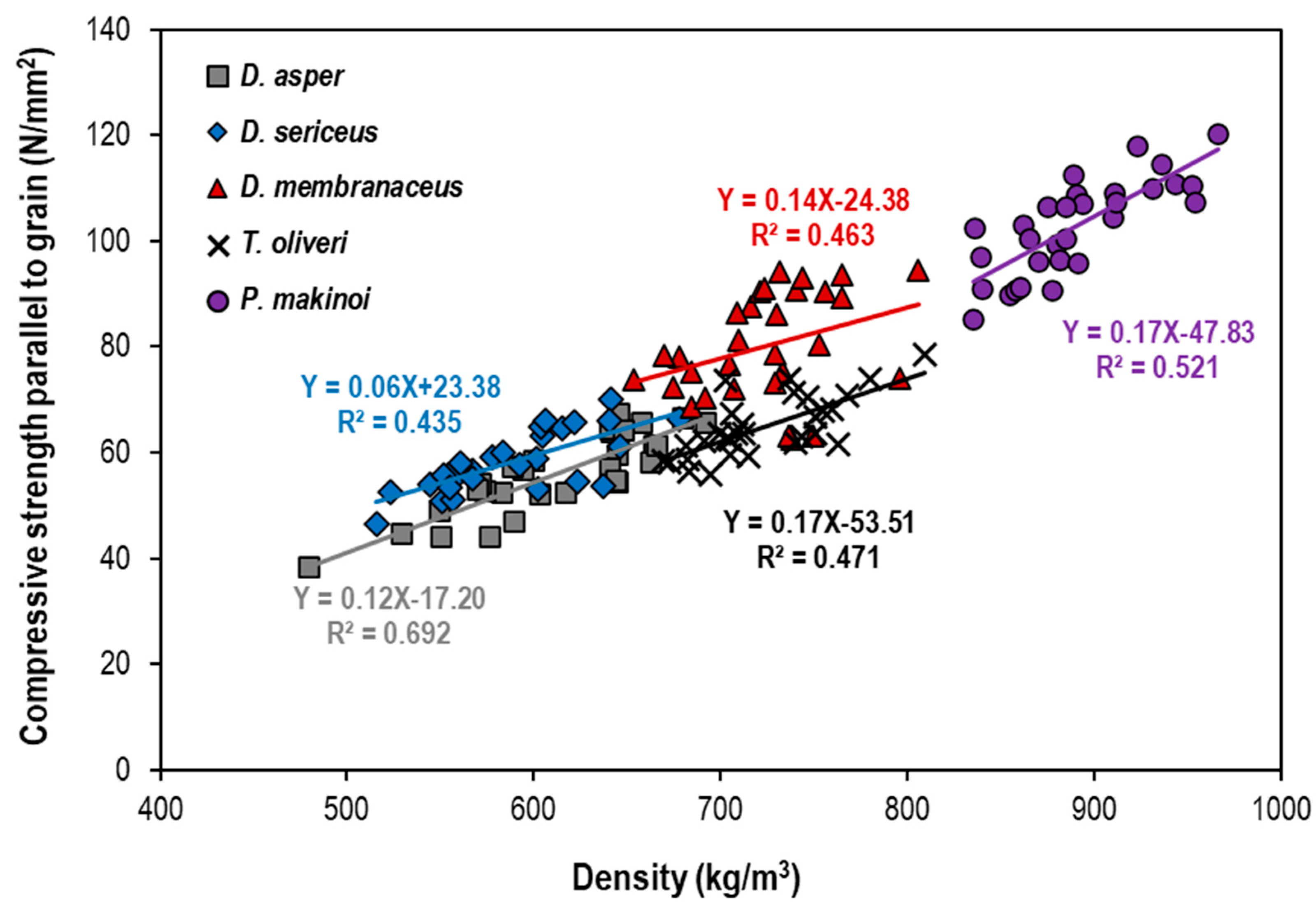

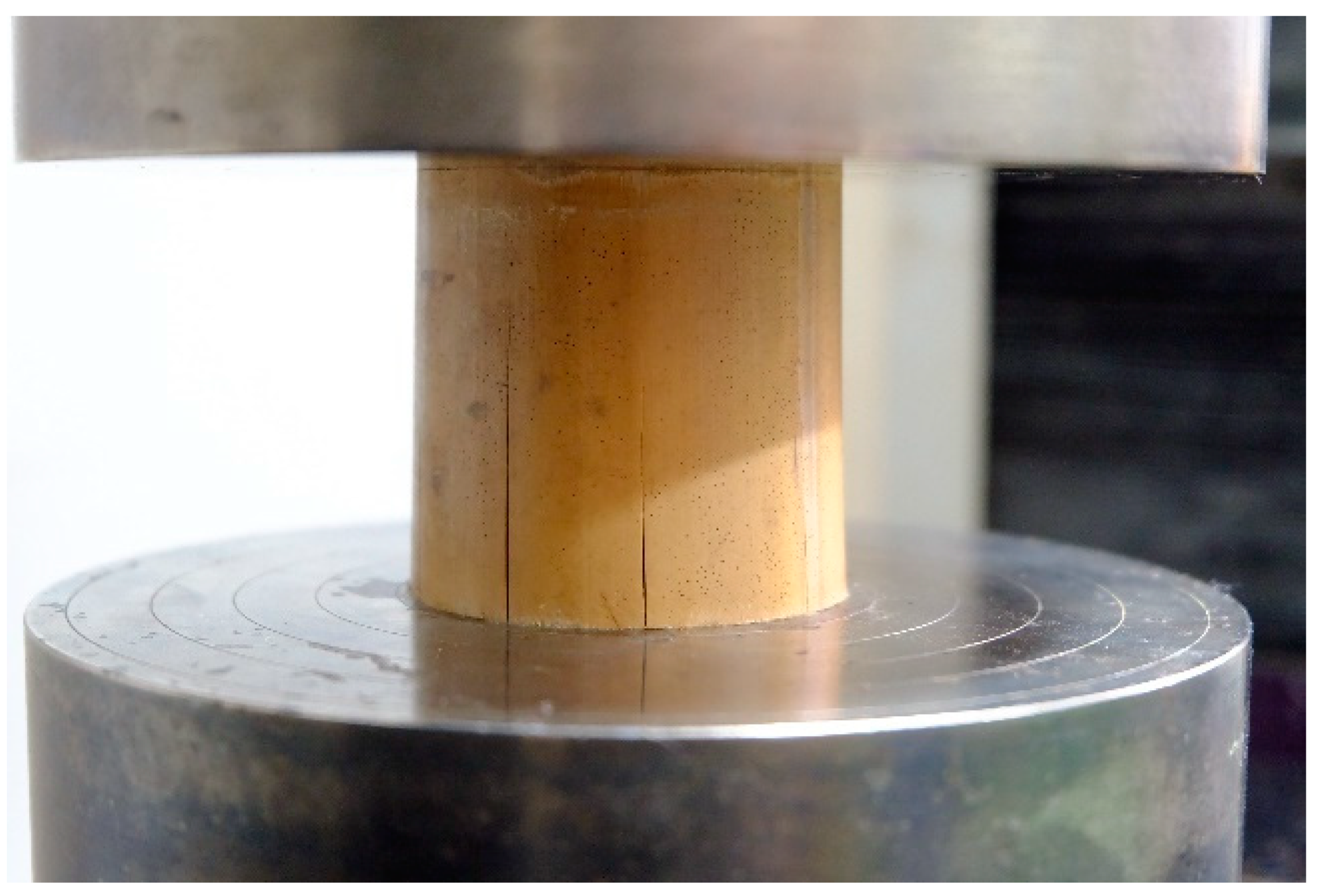
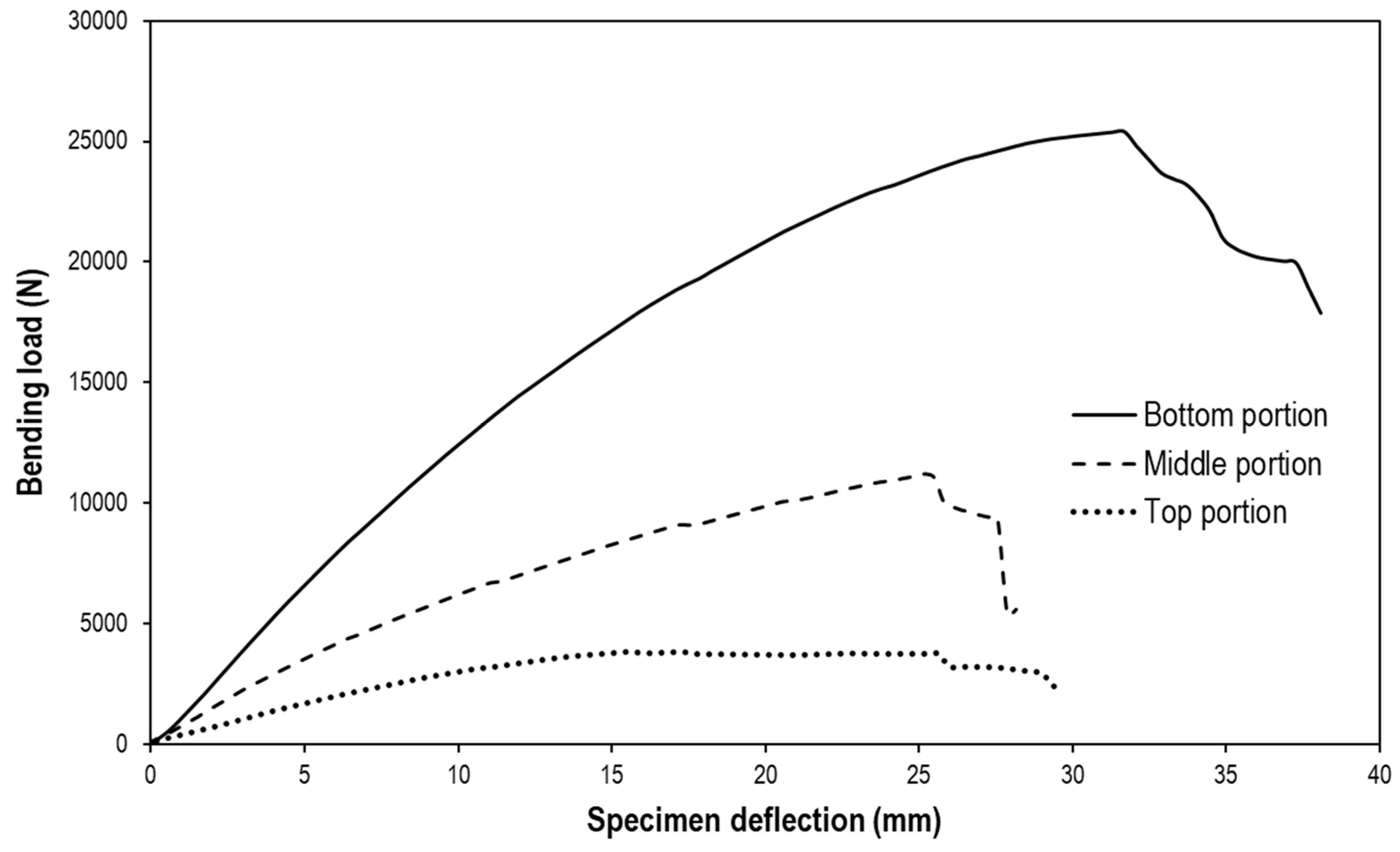
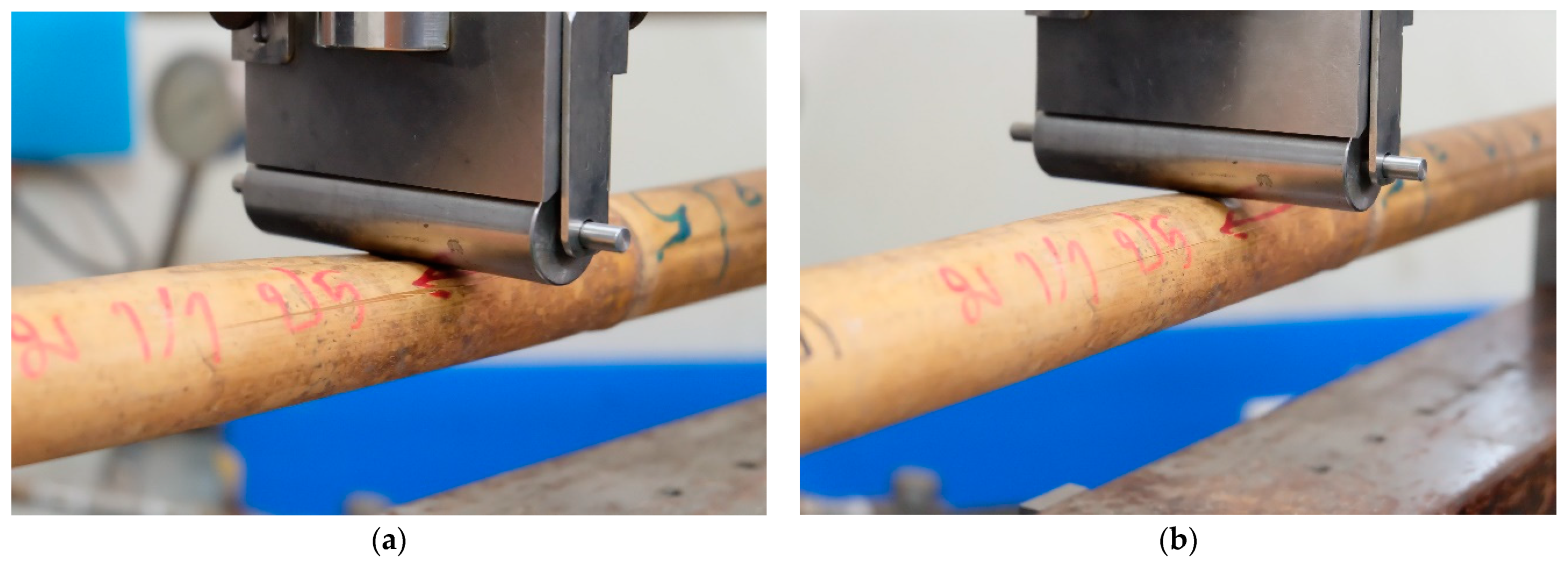
| Culm Properties | n * | D. asper | D. sericeus | D. membranaceus | T. oliveri | P. makinoi |
|---|---|---|---|---|---|---|
| Moisture content (%) | ||||||
| Internode | 30 | 11.52 (0.59) ** | 11.95 (0.49) | 9.99 (0.28) | 13.44 (0.34) | 8.46 (0.44) |
| Node | 30 | 10.24 (0.17) | 11.81 (0.28) | 9.95 (0.95) | 13.19 (0.32) | 8.40 (0.77) |
| Density (kg/m3) | ||||||
| Internode | 30 | 602 (39) | 594 (99) | 712 (54) | 724 (40) | 983 (60) |
| Node | 30 | 596 (40) | 586 (76) | 620 (46) | 706 (84) | 829 (90) |
| Shear strength parallel to grain (MPa) | ||||||
| Internode | 20 | 13.9 (2.1) | 26.8 (4.9) | 13.0 (1.7) | 27.6 (5.1) | 32.4 (7.0) |
| Node | 20 | 15.2 (1.4) | 34.6 (5.8) | 16.8 (2.1) | 31.0 (4.0) | 50.2 (50.2) |
| Tensile strength parallel to grain (MPa) | ||||||
| Internode | 20 | 168 (29) | 120 (31) | 195 (30) | 144 (35) | 216 (37) |
| Node | 20 | 72 (25) | 71 (23) | 82 (27) | 95 (27) | 146 (21) |
| Compressive strength parallel to grain (MPa) | 30 | 56.0 (7.5) | 58.1 (5.7) | 80.2 (9.9) | 64.8 (5.5) | 102.9 (9.0) |
| Modulus of rupture (MPa) | 20 | 58.4 (9.2) | 81.1 (19.0) | 29.3 (10.7) | 68.6 (16.7) | 81.4 (19.0) |
| Modulus of elasticity (MPa) | 20 | 1190 (693) | 3985 (788) | 1306 (699) | 3749 (506) | 4134 (701) |
Publisher’s Note: MDPI stays neutral with regard to jurisdictional claims in published maps and institutional affiliations. |
© 2021 by the authors. Licensee MDPI, Basel, Switzerland. This article is an open access article distributed under the terms and conditions of the Creative Commons Attribution (CC BY) license (https://creativecommons.org/licenses/by/4.0/).
Share and Cite
Chaowana, K.; Wisadsatorn, S.; Chaowana, P. Bamboo as a Sustainable Building Material—Culm Characteristics and Properties. Sustainability 2021, 13, 7376. https://doi.org/10.3390/su13137376
Chaowana K, Wisadsatorn S, Chaowana P. Bamboo as a Sustainable Building Material—Culm Characteristics and Properties. Sustainability. 2021; 13(13):7376. https://doi.org/10.3390/su13137376
Chicago/Turabian StyleChaowana, Kitti, Supanit Wisadsatorn, and Pannipa Chaowana. 2021. "Bamboo as a Sustainable Building Material—Culm Characteristics and Properties" Sustainability 13, no. 13: 7376. https://doi.org/10.3390/su13137376
APA StyleChaowana, K., Wisadsatorn, S., & Chaowana, P. (2021). Bamboo as a Sustainable Building Material—Culm Characteristics and Properties. Sustainability, 13(13), 7376. https://doi.org/10.3390/su13137376







